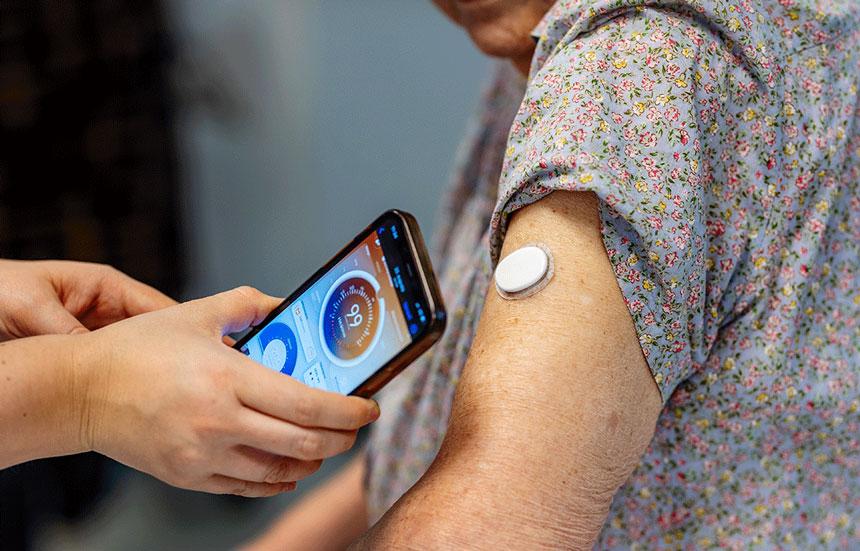How CGMs Are Changing Our Approach to Diabetes, Fitness and More

If you or a loved one has diabetes, you may have seen or heard of a technology called continuous glucose monitors, or CGMs. They are a significant technological advancement designed to assist individuals with diabetes in managing their blood sugar levels more effectively.
A CGM is a small, wearable device that continuously monitors your blood sugar through a small canula inserted under the skin. These devices have evolved significantly over time, incorporating cutting-edge technology to provide real-time glucose readings and trends while sharing that data with other devices including smart phones and insulin pumps.
They’ve also gone mainstream. Not only do people who have type 1 diabetes wear them, but so do people with type 2 diabetes and many people with no diabetes at all. In fact, CGMs have even found their way onto the bodies of elite athletes. But more about that in a minute.
When I first heard about CGMs in the 90s, I knew they would be revolutionary for people with type 1 diabetes. (I’m an endocrinologist by training, so I’ve been around people with diabetes for a long time.) Why? People with type 1 diabetes do not produce insulin and must manage their disease by taking insulin to counteract the food they eat.
This isn’t easy. Over time, blood glucose testing has gotten better and more convenient but there’s nothing fun about the conventional way most people with diabetes had to test their blood sugar. Twenty years ago, type 1s tested their blood sugar six or seven times a day via a finger prick and a device called a glucose meter. The strips that collected blood were expensive, and the constant checking was painful.
But the CGM has changed all that. Now, many type 1s only need to test their blood sugar occasionally – sometimes once or twice a week. The technology can communicate with insulin pumps, which in turn can adjust automatically to blood glucose levels. The combination of CGMs, pumps and sophisticated algorithms have brought us close to the point where management of type 1 diabetes is nearly automated.
In recent years, the technology has also become available for people with type 2 diabetes. There are more than 34 million Americans who have type 2 diabetes, a disease where the body is unable to effectively use the insulin it produces.
Doctors prescribe CGMs to help educate people with type 2, give them in-the-moment glucose readings without a finger stick and gather data on blood glucose events over time. For both doctors and patients, the information is key to tighter glucose control and better outcomes.
A meta study published in 2024 demonstrated that people with type 2 diabetes who used CGMs had lower overall blood sugar and were more aware of high and low blood sugar events.
It’s also being used in people with prediabetes for education and, in some cases, for diagnoses.
What was once a niche tool for people with diabetes is also now being used by non-diabetic athletes and wellness enthusiasts seeking to optimize their health and well-being. Athletes, in particular, have started using CGMs to optimize performance.
When we eat, the carbohydrates in food break down quickly becoming glucose. Our bodies produce insulin to help escort the glucose into our cells. But if we consume a lot of simple carbohydrates at one time, the corresponding increase in insulin can cause a drop in energy levels. For most of us, we may just feel a little tired while our bodies do the work of converting food into useable energy. But athletes can see dips in performance.
CGMs can help them more closely match their fueling needs to their performance and avoid energy inconsistencies or fluctuations. It can also help with recovering and training, one more tool for serious athletes. There are limited studies demonstrating CGM effectiveness for this use, but what’s out there is promising — at least for athletes.
One caveat with CGM and athletic performance, the results are not “real time.” They’re close, but studies in diabetic athletes have shown a lag in data of five to 25 minutes compared to blood glucose measured traditionally. Why the lag? Traditionally, blood glucose is measured from a capillary blood draw – the finger stick. CGMs measure glucose in interstitial fluid versus in the actual blood stream. The results are pretty close, but there’s a time difference in the two measurements.
Multiple factors can affect this, including blood flow rate, body temperature and body acidity, all things that are affected by our various body types and exercise. So CGMs are great for people with type 1 diabetes, educational for people with type 2 and prediabetes and even helpful for athletes. But what about the rest of us?
I started wearing one a few months ago out of curiosity. I don’t have diabetes and I’m not an elite athlete. Still, I learned a lot— I can see the reaction to certain foods I eat. For example, my blood sugar spikes a lot more when I eat white rice, a simple carbohydrate, versus brown rice, which is a whole grain.
Those spikes can lead to higher blood sugar, more insulin and ultimately insulin resistance, which is the underlying cause of prediabetes and type 2 diabetes – which is why doctors like me recommend patients eat more complex carbohydrates instead of simple ones.
Do CGMs have other benefits for people who don’t have insulin resistance? If you’re trying to manage your weight, CGMs can add another layer of data that may help you lose pounds. Not only can CGMs help educate people on the types of food choices they make, but you can see the impact of other behaviors on your health. When we experience stress, for example, our blood glucose levels rise, which then causes our insulin levels to increase. The increase in cortisol, one of our stress hormones, can cause insulin resistance, which subsequently increases belly fat.
The CGM is a window into our complex metabolic processes and a useful tool for people with diabetes, athletes and even those just trying to shed a few pounds.
If you have diabetes or are at risk, you should have a conversation with your primary care doctor or endocrinologist about the technology if they haven’t already had that discussion with you. It’s also worth having the conversation if you’re just trying to understand how your body processes food, too.


